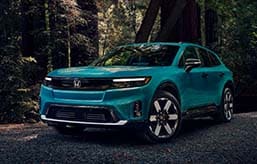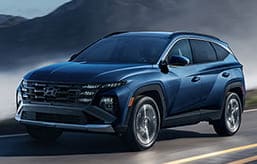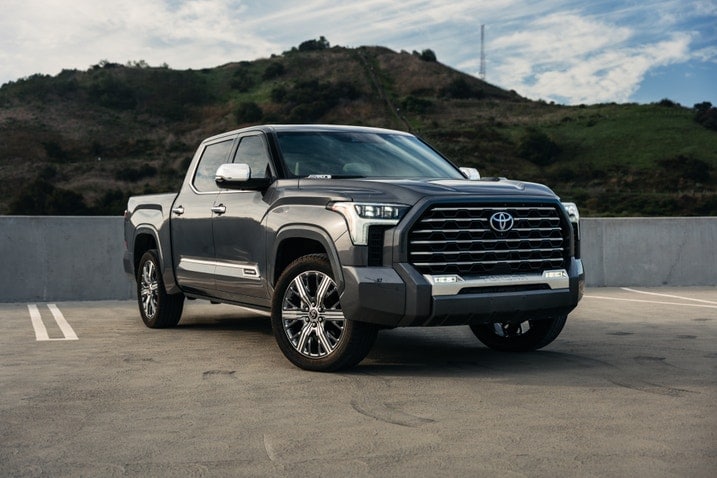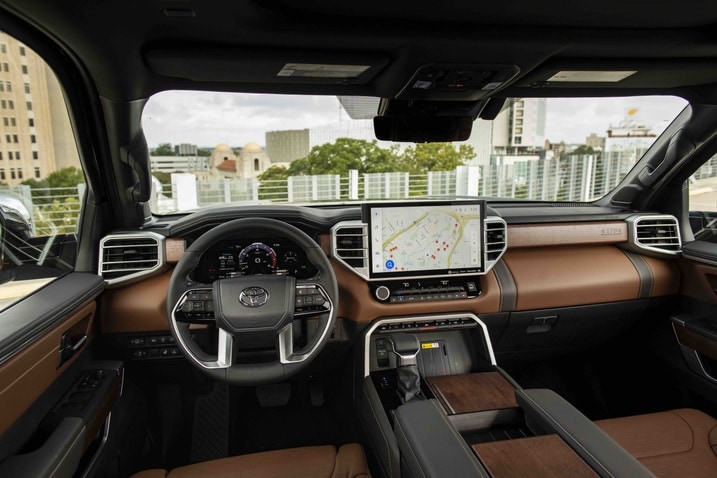- Toyota's Tundra offers full-size truck capability coupled with available hybrid power.
- Tacoma answers back with better fuel economy and more off-road capability.
- What factors are most important in your perfect truck?
2025 Toyota Tacoma vs. Toyota Tundra: Which Truck's Right for You?
The full-size vs midsize face-off
Toyota has redesigned both of its pickups in the last few years. The then all-new 2022 Toyota Tundra broke ground with a revised frame and new rear suspension as well as two turbocharged V6 powertrains, one with electrical assistance. Shortly thereafter, Toyota redesigned its iconic Tacoma in a similar vein. The 2024 Tacoma offered a choice of two turbocharged four-cylinders, one of which also comes with an electric motor between its engine and transmission.
But which of these trucks is the better choice for you? That depends on how you use your pickup, of course. We break down the key decision points below.
Does size matter?
If your needs prioritize space, there's no contest: The Tundra is the bigger truck. Though it doesn't offer more front legroom (the Tacoma actually exceeds it in this dimension, but by less than an inch), every other measurement, especially shoulder and hip room, falls in favor of the Tundra.
If you're hauling passengers in the back, then it's an even bigger no-brainer. The Tacoma's rear legroom is cramped at best, making the Tundra feel positively cavernous in the second row. If you're all about room to move inside, this is your truck.
The Tundra's bed is also bigger and there are three lengths to choose from compared to the Tacoma's two. With 5.7 inches more width between its bed rails, you'll be able to get more cargo in the bed. And even its short bed is more than a foot longer than the Tacoma's short bed.
What about hauling and towing?
It also won't surprise you to hear that the Tundra's maximum payload and towing exceed its smaller sibling's. With a maximum payload capacity of 1,940 pounds, the Tunda can outhaul the Tacoma. But only by about 230 pounds. Keep in mind that the Tundra's maximum payload comes only in the truck few people buy, the 4x2 Double Cab configuration. However, the Tacoma's max payload of 1,710 pounds is found in hybrid-equipped 4x4 Double Cab models. This pairs the heaviest payload rating with a more usable and desirable truck.
Where the bigger truck really shines, however, is in towing. Its maximum tow rating of 12,000 pounds is nearly double the Tacoma's 6,500-pound max rating. Interestingly, the most powerful version of the Tacoma, the i-Force Max hybrid, comes with the truck's lowest tow rating of 5,950 to 6,000 pounds.
Toyota Tacoma vs Toyota Tundra: Specs Compared
Vehicle | 2025 Toyota Tundra | 2025 Toyota Tacoma |
|---|---|---|
| Horsepower (SAE hp) standard powertrain/hybrid | 389 hp (gas engine)/437 hp (hybrid) | 228-278 hp (gas engine)/326 hp (hybrid) |
| Torque standard powertrain/hybrid | 479 lb-ft (gas engine)/583 lb-ft (hybrid) | 243-317 lb-ft(gas engine)/465 lb-ft (hybrid) |
| Transmission type | 10-speed automatic | eight-speed automatic, six-speed manual (gas engine)/six-speed automatic (hybrid) |
| Drive configurations | 4x2/4x4 | 4x2/4x4 (part-time and full-time) |
| Low range | available | available |
| Locking differentials | rear available | center (Limited trim only) plus rear available |
| Ground clearance | up to 11.1 in (depending on trim) | 10.7-11 in (depending on trim) |
| Breakover angle | NA | 23.8-24.6 degrees |
| Approach angle | 21-26.2 degrees | 32.8-35.7 degrees |
| Departure angle | 24-24.2 degrees | 22-22.6 degrees |
| Wheelbase | 145.7-164.6 in | 131.9 in |
| Overall length | 233.6-252.5 in | 213-214.2 in |
| Overall width | 80.2-81.6 in | 76.9-77.9 in |
| Overall height | 78 in | 73.9-74.6 in |
| Curb weight | 5,095-6,185 pounds | 4,145-5,410 pounds |
| Payload capacity | 1,575-1,940 pounds | 1,405-1,710 pounds |
| Towing capacity | 11,170-12,000 pounds | 5,950-6,500 pounds |
| Max headroom | 41 in (front)/38.5 in (rear) | 39.7 (front)/38.4 (rear; w/ sunroof) |
| Max legroom | 41.2 in (front)/41.6 in (rear) | 41.8 in (front)s/33.7 in (rear) |
| Shoulder room | 65 in (front)/62.4-63.4 in (rear) | 58.3 in (front)/57.8 in (rear) |
| Hip room | 62.6 in (front)/60.5 in (rear) | 56.8 in (front)/56.3 in (rear) |
| Bed dimensions (inches) | 65.6 x 58.7 x 20.9 (short), 77.6 x 58.7 x 20.9 (medium), 96.5 x 58.7 x 20.9 (long) | 60.3 x 53.0 x 20.2 (short), 73.5 x 53.0 x 20.2 (long) |
| EPA estimate (combined) | 19-22 mpg | 20-23 mpg |
Off-road advantage
In addition to being smaller and more maneuverable off-road, the Tacoma offers a more aggressive approach angle on the TRD Pro models than is available on any Tundra. Both trucks offer TRD Pro trims that come with Fox internal bypass shocks, which are wildly capable at high-speed off-roading. However, those shocks on the Tacoma are QS3 models with adjustable compression damping, a feature lacking on the Tundra TRD Pro.
Tacoma TRD Pro also comes with coil-sprung front seats. And the Tacoma offers an overlanding-oriented Trailhunter trim with 2.5-inch forged Old Man Emu remote reservoir shocks and 33-inch tires. Bottom line? The Tacoma has a higher focus on off-road use and more options available than the Tundra.
Powertrains and efficiency
The Tundra's two turbocharged V6s are both immensely powerful — the gas version produces 389 horsepower and 479 lb-ft of torque, while the electrically assisted mill cranks out 437 horsepower and 583 lb-ft.
The Tacoma's numbers are more modest but still solid. Its gasoline engine's output is 278 hp in most trims, though SR5 models only get 228 hp. Torque from this powertrain varies similarly between 243 lb-ft and 310 lb-ft. The Tacoma's hybrid powertrain offers 326 horsepower and 465 lb-ft of torque.
With their hybrid powertrains comes striking fuel economy. The smaller truck is, of course, more efficient. The Tacoma's most efficient trims are the hybrid-powered four-wheel-drive trims and gas-powered two-wheel-drive trims, which both earn 23 mpg combined from the EPA. The Tundra's most efficient trims earn 22 mpg combined.
The choice is yours
Perhaps the biggest differentiator between these trucks is towing capacity. If you need to tow a heavy trailer, there's no escaping the need for the Tundra. You'll hardly be the only truck owner who had to buy a full-size truck to accommodate the handful of times a year when you move your heavy trailer. Otherwise, the Tacoma will probably do the job most of the time — especially if off-roading is a priority or you live in a city where its smaller dimensions make for easier maneuverability.








 by
by  edited by
edited by